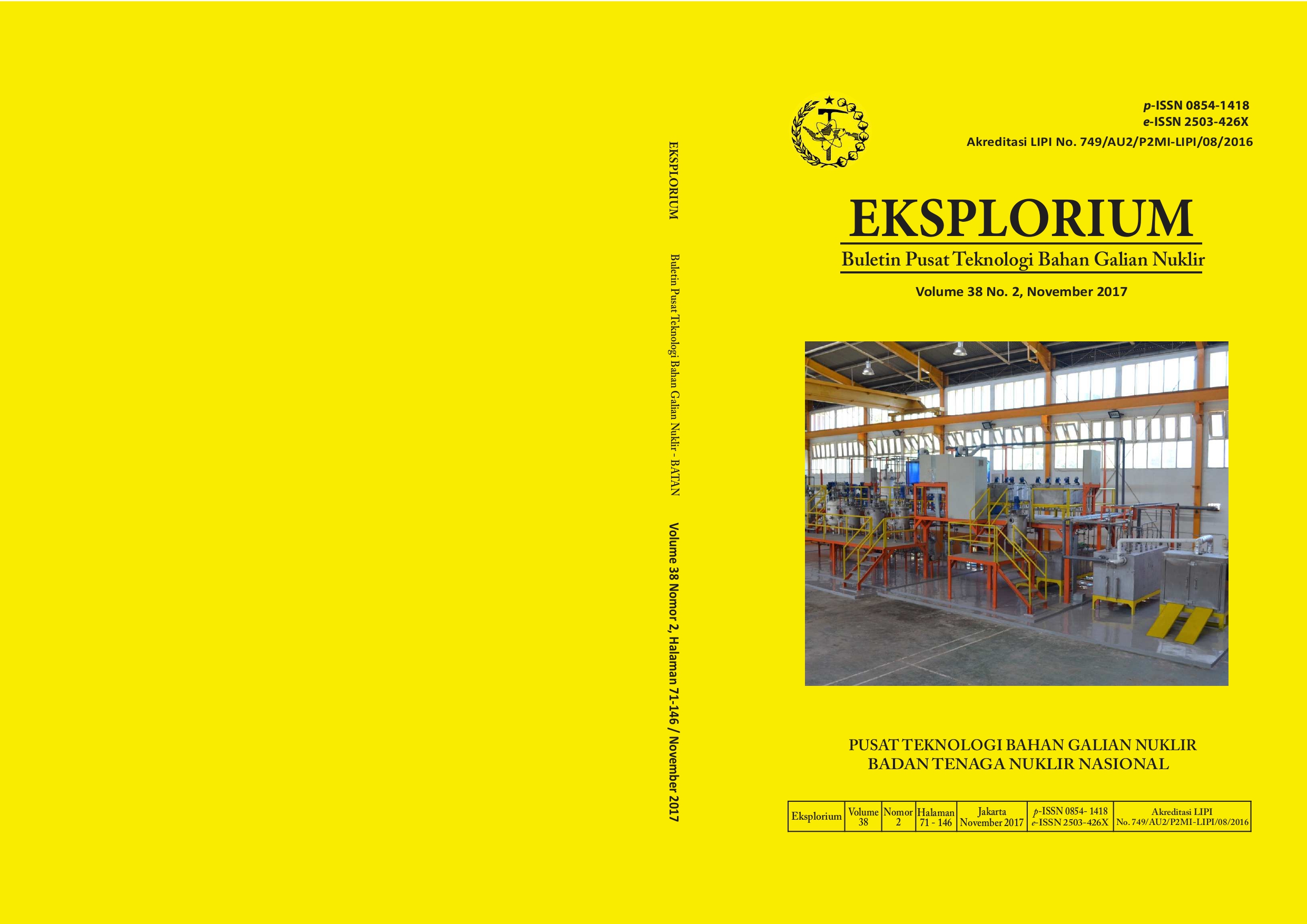Identifikasi Pola Struktur Geologi Sebagai Pengontrol Sebaran Mineral Radioaktif Berdasarkan Kelurusan Pada Citra Landsat-8 di Mamuju, Sulawesi Barat
Main Article Content
Abstract
Article Details

This work is licensed under a Creative Commons Attribution-ShareAlike 4.0 International License.
1. Introduction
By using or sharing content from EKSPLORIUM - Buletin Pusat Pengembangan Bahan Galian Nuklir ("the Journal"), you agree to follow these Terms and Conditions. The Journal's content is licensed under the Creative Commons Attribution-NonCommercial-ShareAlike (CC BY-NC-SA) license. If you do not agree to these terms, please do not use the content.
2. How You Can Use the Content
-
Share: You can copy, share, and distribute the work, but only for non-commercial purposes.
-
Adapt: You can change, remix, or build on the work, as long as it is for non-commercial purposes and you share it under the same license (CC BY-NC-SA).
3. Attribution (Giving Credit)
When you use or share the content, you must:
-
Give proper credit to the author(s).
-
Mention the title of the work and the journal name.
-
Provide a link to the license (https://creativecommons.org/licenses/by-nc-sa/4.0/).
-
Indicate if you made any changes to the work.
4. Non-Commercial Use
You cannot use the work to make money or for any commercial activities. For example, you cannot sell or use the content in advertisements.
If you want to use the content for commercial purposes, you need to get permission from the author(s) or the publisher.
5. ShareAlike
If you make changes to the content (like creating a new version or remixing it), you must share your new version under the same CC BY-NC-SA license.
6. Exclusions
Some materials in the Journal may have different licenses or restrictions, such as third-party content (like images or datasets). You must respect the rules for those materials.
7. No Warranty
The content is provided "as is." The authors and publisher do not guarantee that the content is error-free or suitable for any specific purpose. Use the content at your own risk.
8. Modifications and Withdrawal of Content
The publisher and authors can update or remove content at any time. If content is removed, the previous versions will still follow these terms.
9. Ethical Use
You must use the content ethically and follow all relevant laws. This includes properly citing the original authors and not misusing the content.
10. Legal Compliance
You are responsible for making sure your use of the content follows the laws of your country. If you believe content violates your rights, please contact us.
11. Changes to Terms
These Terms and Conditions may be updated from time to time. Any changes will be posted on the Journal's website.
12. Contact Information
For questions about these Terms or for permission to use content commercially, please contact us at:
-
Email: eksplorium@brin.go.id
-
Website: https://ejournal.brin.go.id/eksplorium
Conclusion
By using the content from EKSPLORIUM - Buletin Pusat Pengembangan Bahan Galian Nuklir, you agree to follow these Terms and Conditions and the CC BY-NC-SA 4.0 International License.
References
[1] D. Iskandar, Syarbaini, and Kusdiana, “Map of Environmental Gamma Dose Rate of Indonesia.” National Nuclear Energy Agency,” 2014.
[2] H. Syaeful, I. G. Sukadana, and A. Sumaryanto, “Radiometric Mapping for Naturally Occurring Radioactive Materials (NORM) Assessment in Mamuju, West Sulawesi,” Atom Indones., vol. 40, no. 1, p. 35, May 2014.
[3] F. Bea, “Uranium,” in Encyclopedia of Geochemistry, C. . Marshall and R. W. Fairbridge, Eds. Kluwer Academic Publishers, London, 1999, p. 712.
[4] S. Krishnaswami, “Thorium,” in Encyclopedia of Geochemistry, C. . Marshall and R. W. Fairbridge, Eds. Kluwer Academic Publishers, London, 1999, p. 712.
[5] N. Ratman and S. Atmawainata, “Peta Geologi Lembar Mamuju, Sulawesi,” Bandung, 1993.
[6] F. D. Indrastomo, I. G. Sukadana, A. Saepuloh, A. H. Harsolumakso, and D. Kamajati, “Interpretasi Volkanostratigrafi Daerah Mamuju Berdasarkan Analisis Citra Landsat-8,” Eksplorium, vol. 36, no. 2, pp. 71–88, 2015.
[7] I. G. Sukadana, A. Harijoko, and L. D. Setijadji, “Tataan Tektonika Batuan Gunungapi di Komplek Adang, Kabupaten Mamuju, Provinsi Sulawesi Barat,” Eksplorium, vol. 36, no. 1, pp. 31–44, 2015.
[8] I. G. Sukadana, H. Syaeful, F. D. Indrastomo, K. S. Widana, and E. Rakhma, “Identification of Mineralization Type and Specific Radioactive Minerals in Mamuju, West Sulawesi,” J. East China Univ. Technol., vol. 39, pp. 39–48, 2016.
[9] W. S. Ibrahim, K. Watanabe, and K. Yonezu, “Structural and litho-tectonic controls on Neoproterozoic base metal sulfide and gold mineralization in North Hamisana shear zone, South Eastern Desert, Egypt: The integrated field, structural, Landsat 7 ETM+ and ASTER data approach,” Ore Geol. Rev., vol. 79, pp. 62–77, 2016.
[10] S. A. Meshkani, B. Mehrabi, A. Yaghubpur, and M. Sadeghi, “Recognition of the regional lineaments of Iran: Using geospatial data and their implications for exploration of metallic ore deposits,” Ore Geol. Rev., vol. 55, no. C, pp. 48–63, 2013.
[11] U.S. Geological Survey (USGS), “Landsat — A Global Land-Imaging Mission,” U.S. Geol. Surv. Fact Sheet 2012-3072, no. May, p. 4, 2012.
[12] A. S. Sastratenaya, “Deformation et Mobilite Megaprisme Tectonique De Pinoh-Sayan, Kalimantan, Indonesie,” These Docteur, L’Universite Louis Pasteur De Strassbourg, France, 1991.
[13] S. O. Hermi, R. Fadlalla, A. Elsheikh, M. Aziz, and S. Bouaziz, “Structural Interpretation of Lineaments Uses Satellite Images Processing : A Case Study in North-Eastern Tunisia,” pp. 440–455, 2017.
[14] Yuliastuti, H. Susiati, Y. Daud, and A. S. Sastratenaya, “Identifikasi Sistem Kelurusan Di Tapak Banten Menggunakan Data Citra Satelit SPOT-5,” JPEN, vol. 15, no. 1, pp. 9–16, 2013.
[15] International Atomic Energy Agency (IAEA), Guidelines for radioelement mapping using gamma ray spectrometry data. 2003.
[16] B. Brahmantyo and Bandono, “Klasifikasi Bentuk Muka Bumi (Landform) untuk Pemetaan Geomorfologi pada Skala 1:25.000 dan Aplikasinya untuk Penataan Ruang,” J. Geoaplika, vol. 1, no. 2, pp. 71–78, 2006.

